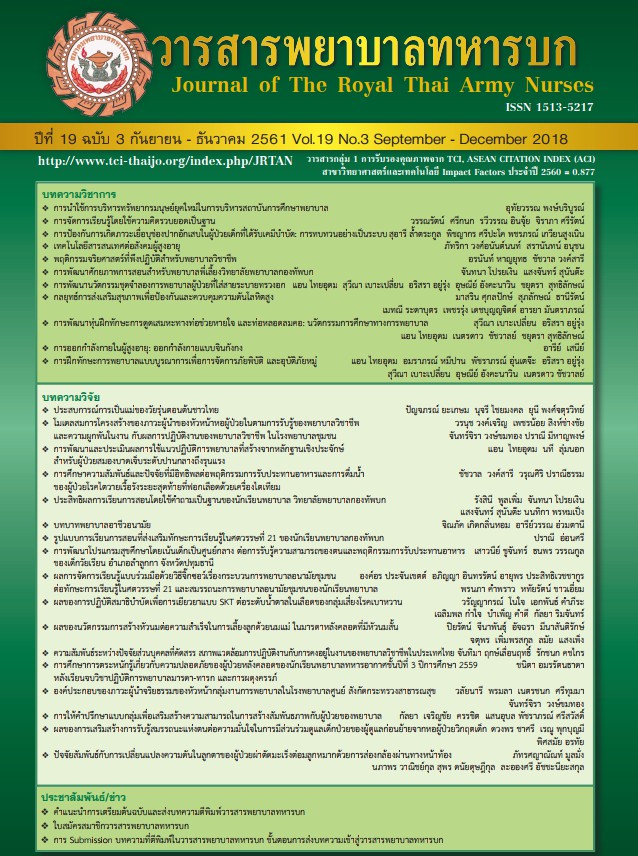The Integrated Training Program for Mass Casualty and Disaster Nursing Management
Keywords:
The Integrated Training Program, Mass Casualty, DisasterAbstract
The Royal Thai Army Nursing College initiated the Integrated Training Program for Mass Casualty, and Disaster Nursing Management called “Yok Pirarak Operation” in the academic year of 2014. In the first year, the training was a three-day extracurricular activity which was part of The Graduates’ Identity and The Institute’s Uniqueness Development Program. The purpose of this program was to develop our expected graduates to have desirable qualities identified: “Outstanding Military Attribute, Public Mind Emphasis, Excellent Wisdom with Morality and Nursing Value Development in Every Situation.” Fostering the identity and uniqueness requires adequate preparation for our future nursing graduates to be capable of working in various situations both in-hospital and pre-hospital settings in cases of peaceful, disaster or wartime events. The training program focused on improving knowledge and nursing skills essential for mass casualty and disaster management in pre-hospital settings. This program was an additional component from the previous nursing program which mainly addressed in-hospital care. In the academic year of 2015, it was included in the nursing curriculum as part of the Nursing Comprehensive Practicum Course for the first time and the program was extended to five days. The program included class lecture, core-skills training, tabletop exercise, real-like scenarios for managing mass casualty, disaster and military events and debriefing. According to the overall 3-year program evaluation, the nursing students participated in the training program perceived that the training was practical in improving their knowledge and core nursing skills required to work in various situations. Also, they reported that the intensive training was effective in fostering several desirable attributes: leadership, discipline, teamwork, communication, critical thinking, problem-solving, decision making and limited resources management. The participants also demonstrated a great pride of being part of the training program. The Nursing college has strong determination to reinforce our identity and uniqueness, and encourage our graduates’ application and integration the obtained knowledge and nursing skills to accomplish future potential missions for effectively serving the Royal Thai Army, the society and the nation in every situation.
Downloads
References
2. Arbon P, Bobrowski C, Zeitz K, Hooper C, Williams J, Thitchener J. Australian nurses volunteering for the Sumatra-Andaman earthquake and tsunami of 2004: A review of experience and analysis of data collected by the Tsunami Volunteer Hotline. Australasian Emergency Nursing Journal. 2006;9(4):171-8.
3. Kako M, Mitani S, Arbon P. Literature review of disaster health research in Japan: focusing on disaster nursing education. Prehosp Disaster Med. 2012;27(2):178-83.
4. Fung OWM, Loke AY, Lai CKY. Disaster preparedness among Hong Kong nurses. Journal of Advanced Nursing. 2008; 62(6):698-703.
5. O’Sullivan TL, Dow D, Turner MC, Lemyre L, Corneil W, Krewski D, et al. Disaster and emergency management: Canadian nurses’ perceptions of preparedness on hospital front lines. Prehospital and disaster medicine. 2008;23(3):s11.
6. Yang YN, Xiao LD, Cheng HY, Zhu JC, Arbon P. Chinese nurses’ experience in the Wenchuan earthquake relief. International nursing review. 2010;57(2):217.
7. The Royal Thai Army Nursing College, Army Nursing Students’ Manual, Bachelor of Nursing Science Program, 2018. (in Thai).
8. The Royal Thai Army Nursing College, The Graduates’ Identity and the Institution’s Uniqueness Development Program, 2015. (in Thai).
9. Daily E, Padjen P, Birnbaum M. A review of competencies developed for disaster healthcare providers: limitations of current processes and applicability. Prehospital and disaster medicine. 2010;25(5):387.
10. Chan SSS, Chan WS, Cheng Y, Fung OWM, Lai TKH, Leung AWK, et al. Development and Evaluation of an Undergraduate Training Course for Developing International Council of Nurses Disaster Nursing Competencies in China. Journal of Nursing Scholarship. 2010;42(4): 405-13.
11. FitzGerald GJ, Aitken P, Arbon P, Archer F, Cooper D, Leggat P, et al. A national framework for disaster health education in Australia. Prehospital and disaster medicine. 2010;25(1):4.
12. Collander B, Green B, Millo Y, Shamloo C, Donnellan J, DeAtley C. Development of an “all-hazards” hospital disaster preparedness training course utilizing multi-modality teaching. Prehospital and disaster medicine. 2008;23(1):63.
13. Scott LAMD, Carson DSPF, Greenwell IBBS. Disaster 101: A Novel Approach to Disaster Medicine Training for Health Professionals. Journal of Emergency Medicine. 2010;39(2):220-6.
14. Hsu EB, Jenckes MW, Catlett CL, Robinson KA, Feuerstein C, Cosgrove SE, et al. Effectiveness of hospital staff mass-casualty incident training
methods: a systematic literature review. Prehospital and disaster medicine. 2004; 19(3):191.
15. Gebbie KM, Qureshi K. Emergency and Disaster Preparedness: Core Competencies for Nurses. The American Journal of Nursing. 2002;102(1): 46-51.
16. Academic Affair Division, the Royal Thai Army Nursing College, The Integrated Training Program Manual (Yok Pirarak Operation) the Academic year 2015, 2016. (in Thai).
17. Kirkpatrick DL, Kirkpatrick JD. Evaluating training programs: the four levels. 3rd ed. San Francisco, CA: Berrett-Koehler; 2006.
18. Yok Pirarak Operation Training Manual (the Academic year 2016), Academic Affair Division, the Royal Thai Army Nursing College, 2017.
19. Prihatiningsih TS, Widyandana, Hapsari ED, Helmiyati S, Ananda AJN. A lesson learnt: Implementation of interprofessional education in disaster management at the Faculty of Medicine Universitas Gadjah Mada, Indonesia. Journal of Interprofessional Education & Practice. 2017;9:121-5.
20. Atack L, Parker K, Rocchi M, Maher J, Dryden T. The impact of an online interprofessional course in disaster management competency and attitude towards interprofessional learning. Journal of Interprofessional Care. 2009;23(6):586-98.
21. Onsri P, Thaiudom A, Pathumkaew P. An Evaluation of emergency medical service nursing course at Phramongkutklao Hospital. Journal of the Royal Thai Army Nurses. 2013;14(3):125-32. (in Thai).
Downloads
Published
How to Cite
Issue
Section
License
บทความหรือข้อคิดเห็นใดใดที่ปรากฏในวารสารพยาบาลทหารบกเป็นวรรณกรรมของผู้เขียน ซึ่งบรรณาธิการหรือสมาคมพยาบาลทหารบก ไม่จำเป็นต้องเห็นด้วย
บทความที่ได้รับการตีพิมพ์เป็นลิขสิทธิ์ของวารสารพยาบาลทหารบก
The ideas and opinions expressed in the Journal of The Royal Thai Army Nurses are those of the authors and not necessarily those
of the editor or Royal Thai Army Nurses Association.






